
Our proud sponsors:














The Apple iPhoneApple changes the world. Again.by Conrad H. Blickenstorfer
14 years ago I bought a Newton. It changed my life. It spawned a magazine, Pen Computing. It became a career in publishing. It spawned Digital Camera Magazine also. When the iPhone came out, I ordered one from Apple. I think it just may change my life. Again. Here's my iPhone story, and what I think of it.
I was both surprised by how small and how big it is. Small compared to my video iPod which is a tad wider and almost as long as the iPhone. The iPhone is a little bit thicker, but looks bigger and more substantial due to its more rounded chrome body. Big compared to my other phones, including the relatively large Motorola RAZR.
So what was my next reaction? This being Apple, everything is ultra-elegant. There is no ugly plastic or cardboard packaging. The box is a triumph in design itself. There is also no large manual with the usual pages of idiot warnings and clunky graphics. In fact, the black folio contains just four things: a black suede cloth to clean the display, two white Apple stickers, a very thin and small product information booklet, and a "Finger Tips" harmonica foldout that shows all the things you can do with the iPhone (a full iPhone manual can be viewed or downloaded from Apple).
Digging deeper into the box I find the beautifully designed white dock and charger, both protected by clear plastic. The dock is very small and surprisingly heavy. A white three-foot cable connected to the dock and on the other side, via a USB jack, either into the Mac or into the small, rounded power supply.
Sigh. I already have two cell phone contracts, one with T-Mobile and one with Sprint. I really cannot cancel either of them without incurring a big penalty, so signing up for yet another plan just to experience the iPhone hurts. And plans start at $59.99. That includes unlimited data, which is good, but only 200 SMS messages - unconscionably few given they're just a few bytes - plus likely the usual gaggle of fees and taxes.
Next I am asked for my Apple ID and fill that in, including password. Apple identifies me, then asks me if I am at least 18 and if I want special offers. Sure. Why not. And I am definitely 18. Several times over. Next I need to enter my billing address and supply my Social Security #, the one that was never supposed to be used for anything other than social security. That submitted, AT&T now attempts to verify my address. It finds me and now I need to accept the iPhone terms and conditions, and then the AT&T service agreement.
Now I can review the info. Ouch. AT&T also charges me a "one-time AT&T Activation Fee" of $36. There is a reason people have... ummm... mixed feelings about phone companies. I mean it's all automatic. Accept that and AT&T asks for up to 3 minutes to check me out. I pass muster and my iPhone is being activated. I get my phone number, and an email is sent to my .mac address to confirm. My iPhone will notify me when activation is complete.
The next screen begins setting up my new iPhone. I can set it so it automatically syncs my address book contacts, iCal calendar, mail accounts, and Safari bookmarks every time I connect. The syncing happens quickly and the iPhone tells me it's now activated. Shortly after, I get a text from AT&T inviting me to learn about the iPhone. I am, however, still busy. I wonder, for example, if I should really sync my mail accounts. My main account has many thousands of messages and might well use up too much space. Well, apparently it just syncs the accounts I have, and not their content. It will, I suppose, sync IMAP4 accounts.
Next I go to "Music" and here I can determine whether I want all music or just selected playlists. Unfortunately, the software doesn't tell me how much space my music takes but I don't have many songs, just over 100, so I select all songs. Oops. I selected a big audio book as well -- Jeff Hawkins' "On Intelligence" -- and that takes some extra space. So that took 570 megabyte of the iPhones 7.24 available gigs. I can see that serious audiophiles will very quickly ask for much more space.
Now I move on to Photos. Those are dear to me and I'd love to have them on my iPhone. But I have over 7,000 in iPhoto (on a PC, you can sync with Adobe Photoshop Album 2.0 or later or Adobe Elements 3.0 or later, or - in fact - with any folder that contains pictures) and again no clue how much space they take, or what size they will be on the iPhone. Doing a bit of research I learn that you can view not just photos but also all sorts of documents by saving them as PDFs into iPhoto. That is good to know. I see no information on what iTunes might do with pictures when it downloads them onto the iPhone and so decide to just try syncing my last three rolls, 776 pictures total. I start the process and iTunes is first "optimizing photos" for my iPhone, and then syncing them. The 76 pictures take 49MB, so it is definitely not advisable to sync my entire library unless I want to pretty much fill up my iPhone's memory right off the bat. So at least I go for the Last 12 Months, a total of 2,093 pictures. The optimization process is not very fast at about half a second to a second per picture, so that takes about 20 minutes for optimizing.
While the syncing process was still underway I received an email from Apple, thanking me for registering my iPhone. Well, technically I never did that, but I guess the activation and setup process took care of that.
As with songs, the actual syncing process takes significantly less time than the optimizing. And my 2,093 pictures took 1.33GB, still leaving me with 5.34GB of free space.
Now I select a few of my videos (you can also download TV shows, of course). One of my home-made ones, iTunes informs me, will not play on the iPhone and will be skipped. Oh well.
So that's that for iTunes. With the iPhone connected, I can see what all I have on my iPhone, separated into Music, Movies, TV Shows, Audiobooks and Type/Group of music. iTunes informs me it's okay to disconnect.
Right off the bat, the iPhone just doesn't feel like a phone. It's more like a next-gen iPod. The screen is almost impossibly sharp and crisp. The main portion of the screen shows nine gorgeous icons, the bottom a row of four more, presumably the main ones: Phone, Mail, Safari, and iPod.
I start with the camera, take a picture, and I'm instantly thrilled with how easy it is to zoom in and out, and to pan around. It is intuitive to the max.
Then I start the browser. The iPhone finds my WiFi network, asks for my WEP code and I am off browsing. My favorite site comes up, tiny, but when I rotate the iPhone into landscape, the screen rotates as well, by itself. Cool. ...
Oh, and let's check this out. And this ...
The browser is sensational, or as sensational as it gets on a small screen. You can seamlessly zoom in and out in an entirely novel way, so nothing is ever too small or too big. How does it work? You simply "pinch" the screen with two fingers. Together shrinks, apart enlarges. If you want to read a column, double-tapping expands it so it fits the screen. Sure, it is not like a browser on a huge LCD, but it works far better than any other PCA or smartphone browser I ever used. Unlike most PDA-style browsers that only let you open one page at a time, Safari on the iPhone lets you open multiple pages. If you do, a small icon at the bottom shows how many. You can then just flip through them.
But let's take a look at the iPhone's main applications.

PhoneCalling and everything else is totally intuitive. In Phone mode, along the bottom are five icons: Favorites, Recents, Contacts, Keypad, and Voicemail. You can use the large keypad or just tap a number in the contacts list or a favorites list you can set up. When you call, a semi-opaque overlay shows the call options. You can bring up the keypad, mute, switch to speaker, add another caller so you can conference them in, put someone on hold, or call up contacts. If someone pesky calls, you can push the sleep/wake button to silence it, or push it twice to make the call go to voice mail directly. With voicemail, you don't need to wade through them all in sequence. They are listed and you can pick whichever want to listen to first. And it's connected to the Maps application described farther down. I can make it so see my house with my contact info. Or anyone else's if I have an address.SafariThe iPhone browser is terrific. First impressions are confirmed over and over. It's (almost) full Safari on a half VGA screen. You get the real thing, not some sort of stripped pages. Loading a site is amazingly fast. Even when you're out of the range of WiFi, the EDGE network does just fine. I was concerned that constantly having to resize the screen to be able to read it would be a total turn-off, but it is not. As mentioned, to have a column fill the screen width, you just tap. When you need to enter a login into a text box, tap on that and it immediately expands to full size. There is considerable smarts built into this version of Safari. The "pinch" method of seamless zooming works very well. You get used to it almost instantly.The biggest complaint is that, as of this writing (end of July 2007), Safari on the iPhone does not have a Flash player. That's a fairly big limitation as many apps use Flash, YouTube needs it, and you can't see many banners and often whole sites. Apple is supposedly working on the problem. iPodAs far as music goes, the iPhone works very much like an iPod. In fact, the "iPod" icon is one of the four major ones at the bottom. Obviously, the iPod's signature wheel and interface aren't there, but the iPhone's is just as simple and intuitive. A neat extra is that when you turn the iPhone landscape, the screen turns landscape and you can now use "Cover Flow," Applespeak for visually browsing through album artwork. As is, in iPod mode you have five icons at the bottom of the screen: Playlists, Artists, Songs, Videos, and "More," which brings up a walking menu list of things. The iPhone lets you replace any of those icons at the bottom with other ones you use more often. For example, if you're a Podcast person, you'd want the Podcasts icon down there.
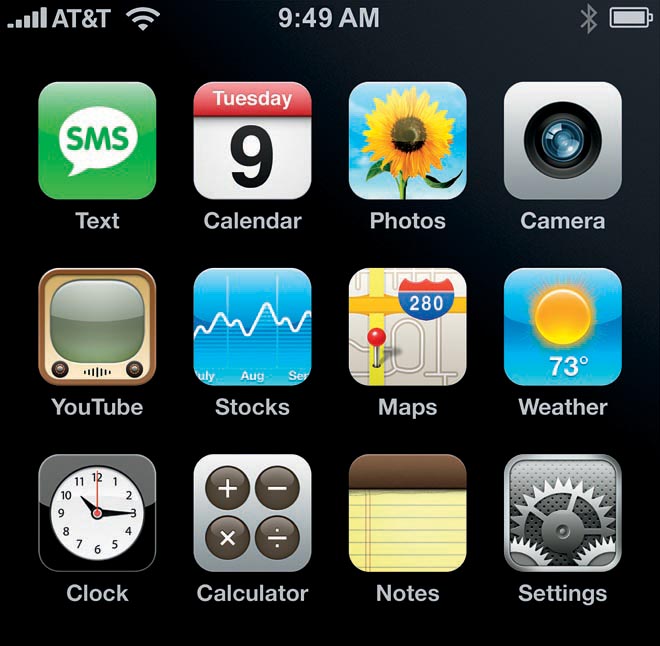
Above is the iPhone main screen with all the apps. They can't be changed or rearranged, at least not now. SMSThe SMS application is very well done. Clicking on the SMS icon first brings up a list. Back and forth conversations with the same person are saved and viewable in text balloon mode. From there you can tap to retrieve contact info, call the person, or respond. The sole obnoxious part is that the basic AT&T plan only includes 200 SMS messages. If you want more, that'll be another ten bucks. Given how very little space text messages take, it's annoying to the max that users are limited to this extent. But all phone companies do it, and get away with it.CalendarI am not a calendar and schedule person, so the basic functionality offered by the iPhone calendar suits me fine. You can view things as a list, a day or a month. Adding appointments is simple and uses one of the iPhone's more endearing features: you pick the date, hour, minute and AM/PM from wheels that spin as if they were in a slot machine. The iPhone uses that metaphor in many apps. Using it feels eerily real as the rotating "drums" act like flywheels. They accelerate when you make them rotate with an up or downswipe of a finger, then decelerate and stop very naturally.PhotosThe Photos is both wonderful and a bit limiting. The wonderful part is that the pictures look awesome on the iPhone screen, you can rotate the iPhone and the pictures go to landscape and fill the screen, you can set up and watch slideshows, and vest of all, you can zoom in and out -- something I miss on my video iPod a LOT. Now, the pics on the iPhone are not full resolution, but you can zoom in a good bit and the picture remains sharp.The not so good part that unlike iPhoto on the Mac, this is strictly viewing only. You can't edit pictures in any way, you can't rearrange them, and you can delete them. So if there are pics you don't need, or don't want seen, you're out of luck. The iPhone cameraThe iPhone's 2-megapixel camera is far better than I expected. To date, every single digital camera in a phone has been a huge disappointment to me, with pictures that barely deserve the name "picture." Why phone makers choose to equip their products with such embarrassing crap has always baffled me. Well, the camera in the iPhone is infinitely better. Its 1600 x 1200 pixel pictures are excellent. Zooming in and out, panning, and syncing pictures is also a total pleasure. On the other hand, you can't do video, and there isn't a single control. So it's point & click to the max.YouTubeThere are other limitations. For example, I was pleased to see a dedicated YouTube icon. I clicked on it and searched for one of my YouTube videos. It did not come up. I did some research and though the Apple documentation says you can "search for any video" apparently you're not actually watching the original YouTube videos on the iPhone. Instead there are several thousand that have been specially prepared to be viewed on the iPhone. Okay, so let me go to the browser and watch them directly on YouTube. Well, YouTube comes up and I can log in, but YouTube complains that the browser is either missing JavaScript or does not have the proper version of MacroMedia installed and so the videos won't play.StocksA basic stock app where you can track your stocks. Changes are shown in dollars and cents or percent. Prices are updated automatically.MapsThe Maps application is excellent. You can bring up your contacts and click on one, and the maps app will find the address and show the satellite map on the screen. It's the same data and same detail as on Google Earth. Which, sadly, also means that the data is just as out of date. The hill behind my house that has some 50 new homes on it still is utterly undeveloped, so the data at least of my area must be three years old. I wish they updated those maps a bit more frequently, especially in booming areas with a lot of construction!Maps also lets you get driving instructions. And, amazingly, in some areas you can get estimated driving times adjusted to traffic conditions. Highway traffic is then indicated in green yellow and red. You can also search for businesses with questions like "italian in folsom California (it brought up ten), or "gas near paradise, ca" (that brought up six). WeatherThe Weather application shows today's weather and a six day forecast, and you can add additional locations. Somehow, the temperature was stuck on 64 degrees Fahrenheit in my home town, though I can attest that it was MUCH hotter. This app often lagged behind and seemed off.ClockThe Clock is the standard World Clock, and there are also very easily usable alarm clocks, stop watch and timer functions.CalculatorNothing special here. It's just your basic four-banger calculator. But unlike so many, the iPhones extremely responsive touchscreen means you don't constantly have to make sure you're actually entering what you mean to enter.Notes and Text entry in generalThe Notes app fills the screen with a mini yellow legal pad. You enter text just one way, with the onscreen keyboard. Notes uses a font that is the same, or very similar, to what the Newton used, so there are some warm fuzzies there for those who were around in the Newton days. Once you're done, you don't have too many options. All you can do is either trash the note or email it. Neither the neat font nor the yellow legal pad background are sent with the note. Even on a Mac, the note arrives as simple text.Text entry on the iPhone is very different than on your standard PDA, though not so different from thumb-type devices. As an old pen computing aficionado, it seems strange to me that 15 years after handwriting recognition was red-hot, though it works better than ever now what with the extra research and much more powerful hardware, it is essentially gone from small devices. On Windows Mobile devices you generally still have the option to pick from various different input methods - onscreen keyboard, character recognition, handwriting recognition, or even additional third party entry methods. With the iPhone you get an onscreen QWERTY keyboard that works amazingly well. You can thumb-type on it or hold the phone and just use your index finger to type (Apple suggests starting with one finger and eventually switching to thumbtyping). When you touch a key, the key shows up large above your finger so you know you have the right one. There is also an audible click. It is relatively easy to hit the wrong key as they are rather close together, so I hoped I could simply rotate the iPhone to get a wider keyboard in landscape mode, but neither mail nor the note taking application do that. That is a serious oversight! Text correction works very well. If you make an error, the iPhone will suggest a correction. If you want to substitute what you typed with the correction, just hit a space, a punctuation mark or return. If you don't want the suggestion, just keep typing. The iPhone will add words it doesn't know into its dictionary after you type them twice and reject the suggested correction. SettingsThis is where the iPhone's various settings reside. Not much to say here; everything is obvious and works well. And there is none of the often needlessly cryptic settings or options you tend to find on Windows Mobile devices.Internet ConnectivityMuch has been said about Apple's choice of AT&T as its sole (for now) carrier partner. The problem is primarily that AT&T's EDGE network is not exactly a speed demon and it's not available everywhere. It's most definitely not a glorious 3G network, the kind that promises download speeds pretty much as you get over cable or DSL at home. So how does the iPhone connect?Well, it first looks for local WiFi. If it finds several it asks which one. If the selected one is locked, it asks for a key. If it finds one you previously used, it connects to that. If I can't find one at all, it connects to AT&T's EDGE network. If EDGE is used, the iPhone cannot do internet and voice calls at the same time. One of the nice things is that the iPhone connects seamlessly. You never have to connect first or go through menus. What amazes me is how fast it all is. I am all too familiar with PDAs that barely move even over 802.11b/g. The iPhone MOVES. Once again, Apple just does it better. Just like old G3 and G4 Macs continue to remain perfectly viable and capable workhorses years after their PC counterparts are on the scrapheap, the iPhone feels quicker, sleeker, more effortless and never, ever kludgy. Even the maligned EDGE network connection works just fine. Yes, it isn't quite as fast as WiFi, but it works and it gets the job done. I've seen reviews that clobber EDGE and the iPhone because YouTube videos don't run as smoothly over it. Boo-hoo. That is certainly not a deal killer for me. The iPhone batteryYou won't worry about the battery in a shiny new iPhone, but eventually it'll become an issue, as the battery becomes an issue in any aging gadget or notebook. Unfortunately, there is no easy way to replace the iPhone's battery. It is not user-replaceable. In fact, it is soldered in. According to Apple, the iPhone offers up to eight hours of talk time, six hours of internet use (WiFi is a power hog), seven hours of video, or 24 hours of audio. And a full battery can last almost two weeks in standby mode. Apple says that a properly maintained battery will till have up to 80% of its original capacity after 400 full charge/discharge cycles. Also according to Apple, a charge cycle means one full charge is used up completely. So does that mean you are better off running down the battery until it's empty before you charge again? No; if you use half the charge, then recharge and the next day use another half charge and recharge, that counts as one full cycle. So what happens if the battery is dead? For now, Apple's out-of-warranty battery replacement costs $79 plus $6.95 shipping, and you'll be without your iPhone for about three business days. It's all described at http://www.apple.com/batteries/iphone.html.As is, battery life is great. Using the iPhone almost constantly for web browsing and exploring, I got the 20% battery left warning after almost seven hours. I can definitely live with that. The iPhone after a weekThere are many gadgets that quickly lose luster. The novelty wears off, and then they go into the big pile of stuff that's really cool, but not quite cool enough to make it part of your everyday life.The iPhone is different. I have it on and with me constantly. I don't leave home without it (and when I do, I place it into one of those colorful Samsonite iPod "socks"). It sits on my nightstand when I sleep. It is right beside me when I work on the computer. I am not sure Apple will like to hear that, but while it's become my favorite cellphone and makes me consider swallowing the early termination fees for a couple of other contracts, it's also sort of become my computer for many tasks. I check my mail on it, even when I am at home. I use it to browse the web. It's very quickly become my SMS tool of choice because it is so much easier to type on it than on a standard cellphone keypad. I like T9 fine, but QWERTY with Apple's error correction is infinitely better. And the IM chat style talk balloons are cool. iPhone 3rd party applicationsHowever, even all that might not be enough had I not discovered something else: Widgets for the iPhone. Yes, there are third party apps for it. Apple even encourages that. If you go to Apple's iPhone page at apple.com/iphone, there is a link to "Web Development for iPhone" that says, "Build Web 2.0 apps like the ones built into iPhone." Basically, what this means is that while for now you cannot just add icons and applications to the clean iPhone interface, you can access and run 3rd party apps that look just like Apple's iPhone applications. Only, they are run through Safari. Essentially, Apple's developer program for iPhone applications development teaches how to create applications that use Safari. There is sample code, guidelines, and everything a developer needs to use Safari and seamless integration into the iPhone look and feel.As a result, iPhone "widgets" are very much unlike OS X widgets that sit on an extra level behind your screen and take annoyingly long to load, so much so that I never use them. On the iPhone, they are just webpages that look like Safari apps. And there are already a bunch out there. As of now, many still just point to some standard mobile web app, and those I don't consider real iPhone apps. But others are indistinguishable from local iPhone apps, and they can GREATLY enhance your iPhone experience. There are whole sites that list iPhone apps: On some you can select by category, others just list them by popularity or the newest first. Since these web apps are not actually added to the iPhone, you need to either bookmark them or add them to one of the several "launchers" available. A launcher looks just like the neatly arranged iPhone homescreen. Black background with beautifully rendered icons. My favorite is uphonehome.com. I wish Apple provided a way to at least add two or three "majors" to the iPhone's own homescreen. As is, you crank up Safari and then have to navigate to your favorite launcher. I create a special "widgets" folder and placed it high up on the bookmarks list, but it'd be even better if I could easily and locally make it my homescreen.So what web apps are my favorites?
JiveTalk is still in alpha, not even beta, but you'd never know. It works great. Sure, a lot of features are not implemented yet and the application dutifully notifies you of what works and what is yet to come, but it is totally stable and endless fun. You can even use it in landscape since it is running in Safari. Excellent! There are also some cool games. A version of "Jewels" (or even a well done knock-off) keeps you entertained, and there are many others. A chess application where you play against the computer works very well. From one of the application launchers listed above you can also access movie lists, Flickr! Interfaces, news readers, calculators, radio stations, numerous games, Gmail, blog apps, cookbooks, weather, directory assistance, movie trailers, TV apps, office apps, social networks and tons more. It's wonderful! More than I ever expected. And with many more to come. The sole problem right now is that in order to access a launcher, you have to bookmark it and then call it up in Safari. It'd be easier if Apple were to allow at least a bit of real estate on the main screen for third party apps. Here are some of my favorites:
Not all widgets are trivial and harmless. There is an application that lets you wirelessly log onto your Mac that has a special application running. You can then do amazing things, like browse the file system, view Word and Excel files, and also pictures, and start applications remotely. You can even look through the iMac's built in camera and run a (fledgling) terminal application. Or look at the entire iMac screen on the iPhone. It's also the only way so far that I managed to lock up the iPhone totally and completely, and had to restart it by pushing and holding the on/off button and the menu button simultaneously. Also, it's not all about fun and games. We're starting to see some serious commerrcial iPhone apps, or setups and services that use the iPhone. A la mode, Inc., for example, offers XSites on the iPhone, a real estate lead management tool that even provides real estate agents the ability to manage website leads on an iPhone. TechnologyWhen I review a product, I almost always peruse its tech specs first. With the iPhone, that just never even came up. It works so well and that specs barely seem to matter. Years ago, Rolls Royce did not release horsepower figures, but merely stated something like "sufficient." Apple is almost in the same position. Its hardware is generally so good that the exact specs barely matter. And so far, the iPhone follows in that tradition. However, I am a hardware guy and so here's the scoop:
The iPhone's radio is a quad-band GSM 850/900/1800/1900 MHz, and it supports the EDGE network. It has 802.11b/g WiFi and Bluetooth 2.0. The terrific LCD is said to come from various sources: Epson, Sharp and Matsushita. The equally impressive touch screen module comes from German Balda and its Chinese partners. The 3.7 Volt Li-Polymer battery is, as stated above, soldered in. The camera is a 2 megapixel affair without any user controls, but it delivers excellent pictures. Apple doesn't specify the processor, and so I can only report what I found online. The iPhone CPU is rumored to be a Samsung-supplied ARM RISC core that's a variant of the S3C2460. Other rumors claimed a Marvell XScale PXA3xx variant, possibly with integrated H.264 and MP3 hardware decoding, and running at 620MHz. In terms of controls and connectors, there is almost nothing. A small docking connector is t the bottom, flanked by the microphone and speaker. There is a small rocker for volume on the upper left side, right next to a small switch to turn off sound. On the top is the headphone jack on the left and a sleep/wake switch on the right. A tiny hole for the camera lens is on the backside of the iPhone, in the extreme upper left corner. The sole other control is the round menu button beneath the display. Unlike the video iPod, the iPhone doesn't have a hard disk (though I wouldn't be surprised if future versions will). Instead, storage is provided by either a 4 or 8GB Samsung NAND Flash chip. The iPhone is, of course, a design triumph, like almost every other Apple product. The front is all smooth black glass, or glasslike material, embedded in a chrome bezel with rounded corners. The body and backside is matte silver metal, with the bottom inch black, probably so it's easier to know which side is up. The iPhone as a phoneThe iPhone is so fascinating that I often don't even view it as a phone. It can do so much more. But a phone it is, and a pretty good one. I have gotten used to flip phones where you get pretty much the perfect angle and length. If a flip phone is open, you have the speaker in your ear and the microphone in front of your mouth. Well, the iPhone is a good two inches shorter than an open flip phone, even a tiny one, so I had to get used again to speaking into seemingly open air. While voice quality is good, there is at times a somewhat annoying background white noise - something I would not expect from a state-of-the-art phone. Conference calls and such are easy to do.But back to the flip phone versus the soap bar or tablet design of the iPhone, or whatever one might want to call it. Despite my misgivings about flip phones, they do make sense. And since most are given away for free or a nominal charge, we don't feel this constant need to baby and protect them. Most are made of plastic and are so light that terms like "drop spec" simply don't appeal. You KNOW they won't break if they fall or take abuse. The gleaming iPhone? A whole different story. I don't think it'd survive a single drop to concrete without getting scratched. I'm afraid I'll see a scratch on its shiny surface every time I pull it out of my pocket. I don't want to mar its beauty by banishing it inside a bulky case, or even one of those cheap rubbery skins. For now it goes into one of those ultra-handy Samsonite iPod socks, the wider variety they no longer make (today, all you can get is the narrow one-size-fits-all Samsonite Nano sock. It doesn't fit. iPhone hatersThe iPhone is so good that I can't imagine anyone would hate it. But someone always does. And in this case vehement, albeit perhaps dramatically overstated, opposition came from within our own camp. One of our most prolific contributors seems so opposed to the iPhone that he suggested we collaborate on an article entitled "100 reasons you don't need an iPhone." When he found that I loved it, he opined, "So, I guess you don't care about productivity anymore. Let's do an article about how you used to be a productive guy but now all you do is poke a screen." Yes that. Others point out that the iPhone doesn't have the ever-important Blackberry-style push email so they can be bugged with email whether they want it or not. Or that there is no expansion slot, or only 8GB of memory (looks pretty good to me compared to the wimpy 64 or 128 meg of a Palm or Windows Mobile device). Then there's the soldered-in battery and, worst, it's from Apple.My iPhone bottom lineTo me it's like coming full circle. 14 years ago I bought a Newton and it changed my life. Now I bought an iPhone and I think it will, too. Apple did it again. What can I say? They simply have what no one else seems to have. That's all there is to it.Conrad H. Blickenstorfer PS: The iPhone after three monthsI get a lot of gadgets and gizmos. Some fascinate me and I use them for a while. Most sort of fade away and get replaced with new ones that come into my office. Every once in a while, one becomes part of my life. The iPhone has. That may have something to do with the fact that getting an iPhone means signing up for two years' worth of phone bill payments to AT&T. Can't ignore that. I mean, it's a lot.But the iPhone has become part of my life. For many reasons. Its sleek, sexy good looks certainly help. It helps that the screen is not only bright and sharp and just plain terrific, but you can actually view it outdoors and in bright light. I hate screens that wash out when I need them most. And it doesn't smudge nearly as much as I had feared. I asked other members of my editorial contributor team to tell me how they like their iPhones, and here's their feedback:
I mostly agree with their assessment. As a phone, I must admit, the iPhone is not without flaws. I am very sensitive to noise, and there is more scratchy background noise in the iPhone than I like. And the number of dropped calls should be a total embarrassment to AT&T (then again, we're talking about an industry where "fewest dropped calls" is used as an advertising point). But all that really doesn't matter that much as the iPhone is somehow more than just a phone. I love to be able to take a picture and email it to someone without having to use some phone company's convoluted proprietary service. And the camera is actually good, not like virtually all other cellphone cameras. It's great to be able to do email, IM, and web browsing pretty much anywhere. The iPhone is pretty good at transparently switching back and forth between EDGE and whatever WiFi network is available for use. What about Safari? What can I say? Apple's Safari implementation on the iPhone is so far ahead of anyone else, it's just plain amazing. How can they get it so consistently right when no one else can? The "pinch" method of zooming in and out by touching the screen with thumb and index finger and then either pinching or moving them apart is just briliant, and it always works. Or double-tapping to make Safari zoom so that the current column fill fits the screen size. I also like being able to quickly switch between up to eight open Safari sessions (though occasionally I've wanted more). Is it perfect? Not totally. Safari has on occasion simply crashed on me. What about all the criticism and drawbacks, all the stuff the iPhone haters bring up as reasons why the iPhone is only, oh, perhaps sixth or seventh or 17th on the list of decent smartphones? Yes, there are some areas where the iPhone is lacking (no Flash, no push email, no video, and so on) but that hasn't dininished my enthusiasm. Flash would be nice and I am sure it'll happen. Ditto for video. Push email? Well, if you need it, then the iPhone is indeed not the right choice. But none of this really matters because the iPhone's appeal simply transcends comparison. It's not about checking boxes on a feature list. For example, above I quoted a contributor saying "Let's do an article about how you used to be a productive guy but now all you do is poke a screen." Far from it. I actually write notes and whole article outlines on the iPhone and then email them to my Mac. Since I can actually use the web on the iPhone, I don't need to wait til I have a desktop PC or notebook available to do work. So productivity hasn't suffered one bit. Au contraire. Well, I must admit that I also use the iPhone for fun. You may not be able to install programs on it (at least not officially), but all those specially formatted websites are really undistinguishable from local applications. I have spent hours just playing "Bejeweled" on the iPhone. My son plays chess on it. And the numerous iPhone portals that have sprung up are hugely useful. Having a real browser makes all the difference in the world. What about the $200 price drop so soon after the initial release? That was perhaps one of Steve Jobs' few bad ideas. But at least he did something about it. I have my $100 credit voucher and may just use it to get an iTouch. So after three months with the iPhone, my bottom line hasn't changed: "Apple did it again. What can I say? They simply have what no one else seems to have. That's all there is to it." Until further notice I stick with that.
|
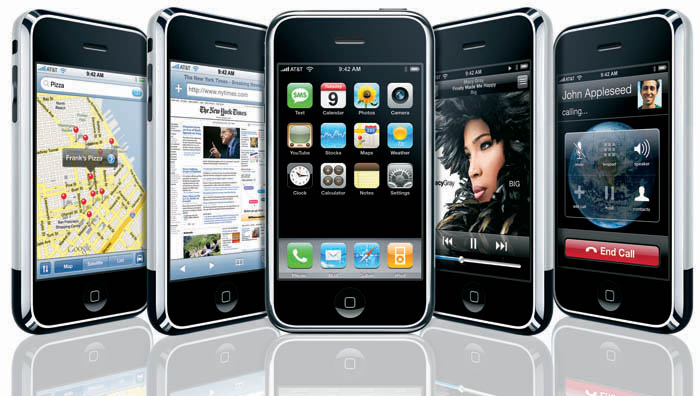
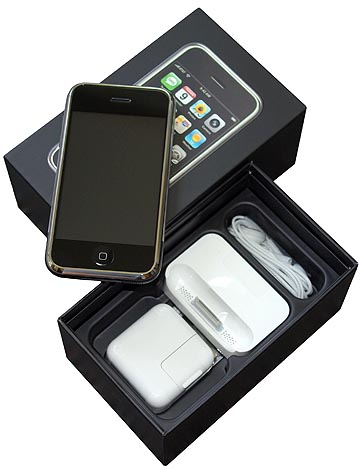 The iPhone goes "Activate iPhone" and connects to iTunes. An iTunes software license agreement pops up (hmmm... I've been using iTunes for years, so why now?). I agree, and now the "Welcome to your new iPhone" screen comes up on the iMac. The second screen asks if I am an existing AT&T customer. I am not. The third asks I if want to transfer an existing cell number or even my home phone number. No, I want a new number. The next screen lets me select a monthly service plan.
The iPhone goes "Activate iPhone" and connects to iTunes. An iTunes software license agreement pops up (hmmm... I've been using iTunes for years, so why now?). I agree, and now the "Welcome to your new iPhone" screen comes up on the iMac. The second screen asks if I am an existing AT&T customer. I am not. The third asks I if want to transfer an existing cell number or even my home phone number. No, I want a new number. The next screen lets me select a monthly service plan.



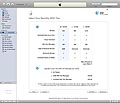

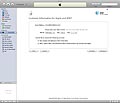
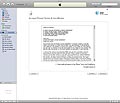
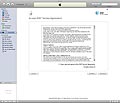
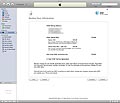
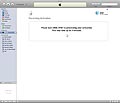
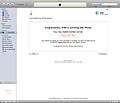
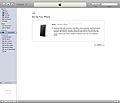
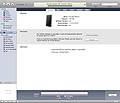
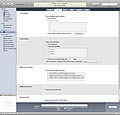
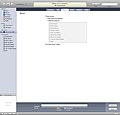
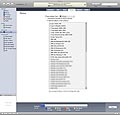
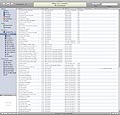
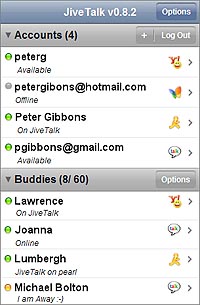 The one I used by far the most is JiveTalk (see screen image on the right). It is a service-independent IM client that supports, among several others, AIM and Yahoo. So instead of having to SMS back and forth, with each SMS eating up one of those precious few that are part of my AT&T plan, I get to IM to my heart's content for free.
The one I used by far the most is JiveTalk (see screen image on the right). It is a service-independent IM client that supports, among several others, AIM and Yahoo. So instead of having to SMS back and forth, with each SMS eating up one of those precious few that are part of my AT&T plan, I get to IM to my heart's content for free.
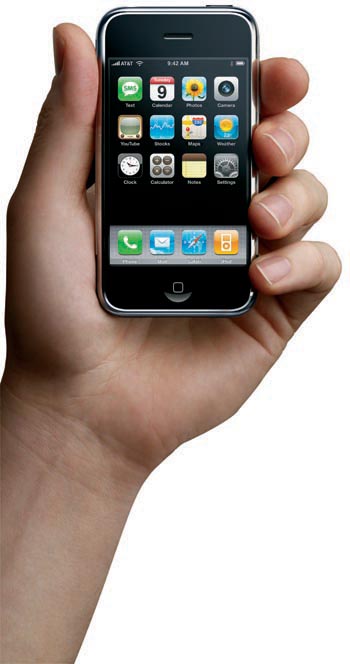 The iPhone measures 2.4 x 4.5 inches and is half an inch thick. It weighs 4.8 ounces. Its display measures 3.5 inches diagonally and has half-VGA resolution - 320 x 480 pixels. That makes for an extremely sharp 160 pixels per inch. Interestingly, the half-VGA resolution is the same as the final Newton had, the MessagePad 2100. The iPhone of course, is a fraction the size and weight of the Newton.
The iPhone measures 2.4 x 4.5 inches and is half an inch thick. It weighs 4.8 ounces. Its display measures 3.5 inches diagonally and has half-VGA resolution - 320 x 480 pixels. That makes for an extremely sharp 160 pixels per inch. Interestingly, the half-VGA resolution is the same as the final Newton had, the MessagePad 2100. The iPhone of course, is a fraction the size and weight of the Newton.